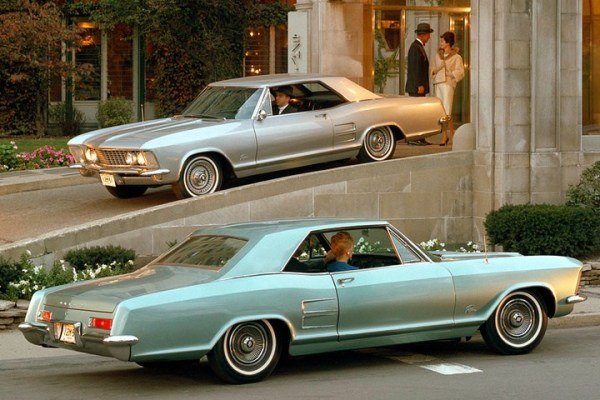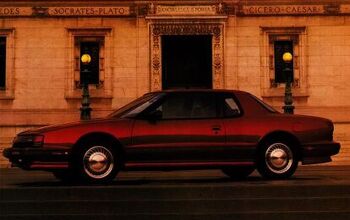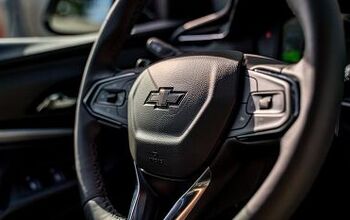Buy/Drive/Burn: Classic Luxury Coupes From 1963

Today’s Buy/Drive/Burn brings three big and brawny American luxury coupes from 1963. You’ll have to burn one — no exceptions.
Ford Thunderbird
By 1963 Ford’s successful Thunderbird was in the final year of its third generation, which was the last of the model’s smooth, bullet-like styling. Available in coupe and convertible variants, the third generation Thunderbird was a darling of television product placement, and one of the stars of JFK’s inaugural parade. For ’61, it also did some work as the Indianapolis 500 pace car. Updates for 1963 included an AM/FM radio and a remote driver’s side mirror. The Thunderbird was available with a single V8 engine, the 390 (6.4L). It produced 300 horsepower, sent to the rear via the three-speed automatic.
Chrysler 300J
Chrysler started their 300 letter series cars in 1955 with the C-300. After that, the letter moved behind the numbering, and each new year was given the next subsequent letter in the alphabet. In 1963 the letter was J, as Chrysler skipped the I to avoid confusion with the Roman numeral. Styling was smoother than prior years, as American cars entered a Sixties aesthetic and designer Virgil Exner exited his position as Chrysler’s chief designer. The new exterior styling was paired with an upscale luxury interior, and a squared-off steering wheel. The 300J was also quick, with a 413 (6.8L) 390-horsepower V8 which powered the big coupe to 60 miles an hour in 8 seconds. Big and expensive, the 300J sold poorly. Just 400 were produced.
Buick Riviera
Buick’s Riviera was brand new for 1963, as Buick once again entered the personal luxury coupe market. The tri-shield brand took some time off to rethink its personal luxury offering after the Super model concluded in 1958. Buick dedicated the Riviera name to the new coupe after its most recent application on the six-window Electra 225 Riviera in 1962. Riviera was the first vehicle on GM’s E-body, which was designated for front- and rear-wheel drive personal luxury cars across the company’s lineup. Said platform would see notable front-drive use three years later, in the Oldsmobile Toronado of 1966. Two V8s were available, of 401 (6.6L) or 425 (7L) cubic inches. With the 425, Riviera had 360 horsepower distributed via an old two-speed automatic, which was only offered in ’63.
With big displacement comes a big decision: One must burn. Which will it be?
[Images: GM, sellers (via Hemmings, Vegas Muscle Cars)]

Interested in lots of cars and their various historical contexts. Started writing articles for TTAC in late 2016, when my first posts were QOTDs. From there I started a few new series like Rare Rides, Buy/Drive/Burn, Abandoned History, and most recently Rare Rides Icons. Operating from a home base in Cincinnati, Ohio, a relative auto journalist dead zone. Many of my articles are prompted by something I'll see on social media that sparks my interest and causes me to research. Finding articles and information from the early days of the internet and beyond that covers the little details lost to time: trim packages, color and wheel choices, interior fabrics. Beyond those, I'm fascinated by automotive industry experiments, both failures and successes. Lately I've taken an interest in AI, and generating "what if" type images for car models long dead. Reincarnating a modern Toyota Paseo, Lincoln Mark IX, or Isuzu Trooper through a text prompt is fun. Fun to post them on Twitter too, and watch people overreact. To that end, the social media I use most is Twitter, @CoreyLewis86. I also contribute pieces for Forbes Wheels and Forbes Home.
More by Corey Lewis
Latest Car Reviews
Read moreLatest Product Reviews
Read moreRecent Comments
- FreedMike Your Ford AI instructor:
- Jeff Good find I cannot remember when I last saw one of these but in the 70s they were all over the place.
- CoastieLenn Could be a smart move though. Once the standard (that Tesla owns and designed) is set, Tesla bows out of the market while still owning the rights to the design. Other companies come in and purchase rights to use it, and Tesla can sit back and profit off the design without having to lay out capital to continue to build the network.
- FreedMike "...it may also be true that they worry that the platform is influencing an entire generation with quick hits of liberal political thought and economic theory."Uh...have you been on TikTok lately? Plenty of FJB/MAGA stuff going on there.
- AZFelix As a child I loved the look and feel of the 'woven' black vinyl seat inserts.





































Comments
Join the conversation
Tough call, as I want none of them. I like the looks of the T bird, but the Chrysler looks awkward to me. The Buick is ok, but I wouldn't want the slushbox transmission. I wouldn't want any of them because they all have drum brakes. If I was a car buyer in 1963 looking for a 2 door coupe I'd have to buy a Jaguar E Type - same price as the T Bird or the Chrysler with a few options added. Base price of the Chrysler was $5260, T Bird $5563 and Buick $4330. Jag was $5500. With hindsight, the Jag is the one to buy if you wanted an appreciating asset, based on current auction prices.
OK, I'll play, because the thinking behind these three models directly explains the death of the 'American' passenger car by the year 2019. Buy the Riviera. GM's talented engineering staff was sometimes almost allowed to build good vehicles. They came close on this one. Drive the Chrysler (a short distance and then park it). Chrysler historically learned on the job and left beta testing to its customers. The upside is increased personal engagement by the owner - because it's up to you to finish the job they started. Burn the Ford. Automobiles are a distracting side business for Ford - their real focus is family politics and internecine warfare.